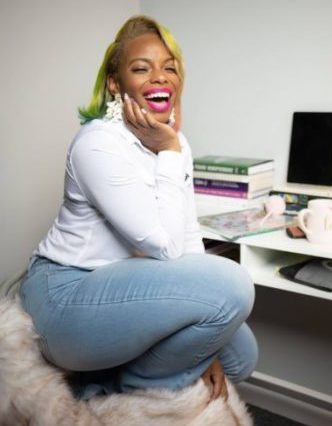The topic of mental health and therapy is one that has been looked at as taboo in many of our households. Historically, black people have opted out of mental health treatment because of the many stigmas that surround it, such as relatability, being labeled as crazy, location, lack of familial support, being told to just pray about it, and the absence of representation. Even though the idea of therapy has since evolved into a more acceptable practice, there are still many barriers.
Here, five black therapists weigh in on the stigmatization of mental health within the black community, and ways overcome it.
 Nicole Osborne, M.S./Ed.S
Nicole Osborne, M.S./Ed.S
I have definitely noticed that there is a stigma surrounding mental health in the black community, both in my graduate assistantship, where I was a counselor and interning with elementary school students. Things I typically heard was how weird, new and uncomfortable therapy was, in addition to the fact that their parents wouldn’t approve of them attending, because certain issues were not talked about in their family.
In the public school system, I saw that many parents would not approve of their child attending counseling or therapy outside of what was already provided at school. For example, I had a student who was exhibiting signs of depression. When brought up to the parent, she brushed it off by saying that her child was alright. She later compared how she dealt with her trauma by lashing out and fighting, versus her child dealing with it by not talking to anyone. After many attempts to get the child services, the parent continuously refused. That was just one of the multiple instances that I’ve seen.
There are several ways to destigmatize therapy and mental health in the black community. Increasing media representation is one of them. One of the examples I loved seeing was on NBC’s This Is Us, when the character Randall, a black man, had a conversation with another black man, Darnell, about mental health and anxiety. It opened up the conversation by providing a window into two different perspectives about mental health in the black community. Darnell admitted to attending counseling for his issues, whereas Randall, who was reluctant at first, later sought out therapy. Other ways to destigmatize mental health is through correct representation and proper education on what mental health is not. It doesn’t mean that you’re flawed, weak, crazy, or that the state of your mental health defines who you are as a human being, it’s just a part of your human experience.
Training culturally competent counselors are also important. There should be continuous learning on how to work with individuals from minority backgrounds and people of color to aid in working with clients of various cultural identities and how it impacts mental health. A big misconception about mental health and therapy is that because you are black, you should have a black therapist. That isn’t always true. Just because you have a black counselor doesn’t mean that they’ll be a great counselor for you. It doesn’t matter what the racial background is of the counselor, as long as they are culturally competent, they should be willing and able to incorporate all of your cultural identities in the counseling process.
Also, another prevalent stigma is affordability. Many people don’t know that some counselors offer sliding scale payments. If you are within a certain income bracket, you can have reduced fees to make counseling more affordable. Also, Medicare covers mental health counseling.
 Bianca J. Clark, LCSW, LPHA, Metropolitan Family Services
Bianca J. Clark, LCSW, LPHA, Metropolitan Family Services
As a therapist, I know that there is a stigma surrounding mental health within the black community. There’s a lot of different reasons why black people are hesitant to receive counseling and any other psychiatric services. Reasons include a lack of information and fear of being labeled as crazy.
In the black and brown communities, there’s the mentality of “What happens in the family, stays in the family,” and it keeps them from being comfortable with sharing their issues. Many people often feel that if they go to church, then everything will be fine. They feel as though their spirituality will be enough to take care of mental illness. Another significant issue is not having enough resources and an inability to access the same resources as other populations.
 Lauren Jackson, LPC, Founder/CEO S.L.A.Y
Lauren Jackson, LPC, Founder/CEO S.L.A.Y
It’s going to take more of us going into the field to show our non-black counterparts who our culture is and what we are about. Also, what we’ve been through and slavery, and how that has affected our mindset. That plays a part in our behavior, in our choice-making, why we are depressed, and anxious. For a long time, our culture didn’t have a title for it. We were just labeled as “being black” and told to suck it up and keep going. Within our community, there is a mindset that because we have been at the bottom of the totem pole, we have to take it all and overcome. We feel that we can’t seek out help because help has never done anything for us.
Although I understand the stigma, this is a time to break it. The African American community faces more trauma in 24 hours than any other culture. From the moment a child wakes up by being spanked by their parent for not getting out of the bed to witnessing domestic abuse in their commute to school, they are experiencing trauma. When we hear trauma, we think that it has to be something big like rape, physical abuse, or neglect. But trauma is what affects you and your mindset to the point where you’re no longer able to function. It changes how you function in your daily life.
It’s going to take people speaking out about what they’re dealing with every day and knowing that they are not crazy for seeing a therapist. It’s also going to take organizations such as Coffee, Hip Hop, and Mental Health, and the way that they are normalizing these experiences by making them a part of the community instead of separate. Using our own language to make mental health more relatable is also going to help. One of the reasons why I named my organization, S.L.A.Y, is because I wanted it to be relatable. I created a series,’ where I talked about lipstick and hair color, because not only can we relate, but I’m using it as a way to shape our identity.
Accessibility is also important. A lot of us, when we go into the field, open up offices that are too far, making it difficult for our people to go, which results in it taking away from our communities. I understand wanting to get out of the hood, but that doesn’t mean that your office can’t be there. I can live outside of the hood and still have my office in the hood. Why? Because my people are there and they are going to get the help that they need.
 Brittany Harris, LMSW, TYCM, The Honeycomb Collective
Brittany Harris, LMSW, TYCM, The Honeycomb Collective
I think that we have come a long way as a people to break down the stigma of mental healthcare within our community and culture. The sentiment has historically been, “What happens in our house, stays in our house” and “Don’t put my business out in the streets.” It has, in large part created this wall between black people and allowing ourselves access to mental healthcare. Also, how mental healthcare is portrayed in the media is playing a role in the shift; however, when we see mental health barriers in the media, it represents the extreme. It makes it feel unrelatable.
A lot of the stigma has come from those things, as well as our culture and upbringing. The people who raised us play a large part in our experiences. What I’m finding is that although my generation is starting to make the shift, it’s not enough. To destigmatize mental healthcare, it’s going to take all of us and not just pockets of people here and there. Mental healthcare has to be just as normal as physical healthcare.
The same way we go to the doctor for ailments is the same way we should seek mental healthcare providers for adverse experiences with our emotions. Also, the way that I promote mental healthcare within our community is using the word “emotion.” People can relate to emotions. For whatever reason, the word “mental” makes people automatically think crazy. But “emotion” can refer to feeling sad, guilty, and shameful, in the same way that it relates to happiness and joy. People want to feel good in general. So I try to help people connect to emotional health and wellness.
 Tiffany Wright, MSW Social Worker
Tiffany Wright, MSW Social Worker
Part of the root surrounding the stigma that we have as a community is connected to our historical distrust of the medical system in the U.S. When you think about what it takes for someone to trust a medical healthcare provider, you have to take into consideration the possible traumas that are connected, and possibly preventing the ability to trust a mental healthcare provider. When you look at all of the experiments and tests that we have undergone, women being treated horribly while developing sciences around reproductive health, and assumed to have a high pain threshold, we carry that ancestral pain through our bodies.
What’s sad and the truth at the same time is that we are such a resilient people that we don’t get the space to feel our feelings. Historically, we don’t get the space to feel “weak” or express the need for help. It’s a narrative that gets carried down. For example, we’re told that if our great-grandmother who suffered abuse could take care of eight children and was dirt poor, then we can live through what we’re living through—no recognition of the fact that she probably had anxiety, depression, or suicidal thoughts.
But there was also no language to offer someone during those times. So people measure their strength or mental health by how much they’re willing to hold. And because they have never been given the opportunity to allow someone to help them to release it, they continue to want to bear the burden of weight(s) that they have in life.
Now, we have more people who are becoming increasingly sensitive and vigilant to situations that are normalized, but not healthy. It’s normalized to be anxious, but we are learning that it’s not normal, meaning healthy or safe to the human body. It’s normalized to take on many tasks at once and push ourselves to hospitalization, but we’re learning that it’s not healthy. There’s a difference between what’s normalized and what’s healthy. The people who are not identifying the difference between the two are still holding on to the taboo. However, the ones who are opting to make healthier choices are the ones who are stepping outside of the stigma.
